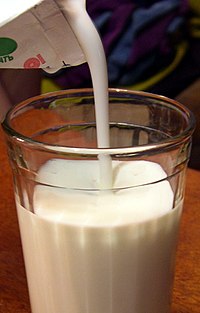
Photo from wikipedia
The present study was conducted to investigate the ability of two probiotic strains, L. acidophilus PTCC 1643 and L. rhamnosus PTCC 1637, to bind aflatoxin B1 (AFB1, 20 ng/ml) in… Click to show full abstract
The present study was conducted to investigate the ability of two probiotic strains, L. acidophilus PTCC 1643 and L. rhamnosus PTCC 1637, to bind aflatoxin B1 (AFB1, 20 ng/ml) in comparison with yogurt starter cultures, at equal bacterial count (~ 109 LogCFU/ml) during a 21-day storage period at 4 °C. All assessed treatments exhibited high percentages of AFB1-binding, ranged from 64.56 to 96.58%. However, the ability of probiotic bacteria was statistically higher than yogurt starter cultures. Aflatoxin binding ability of the selected lactic acid bacteria was dependent on both time and bacteria species. The highest and the lowest percentages of AFB1-removal was observed at 11th day of cold storage by L. rhamnosus (96.58 ± 3.97%) and at the first day of storage for yogurt starter cultures (64.56 ± 5.32%), respectively. The stability of bacterial cells-AFB1 complex was remarkable, since only 0.84–26.75% of bounded AFB1 was released from bacterial cells after 3 times washing during the storage period.
Journal Title: Food Science and Biotechnology
Year Published: 2019
Link to full text (if available)
Share on Social Media: Sign Up to like & get
recommendations!